
Concept explainers
(a)
Interpretation:
The R or S configuration of the chiral center in the given molecule is to be designated.
Concept introduction:
When assigning priorities to substituents, the atom having the greater
When the fourth priority substituent is pointing away (it is attached by a dash bond) and the first, second, and third priority substituents are arranged clockwise, the configuration is R.
When the fourth priority substituent is pointing away (it is attached by a dash bond) and the first, second, and third priority substituents are arranged counterclockwise, the configuration is S.
If the fourth priority substituent is attached by a wedge bond, then the clockwise or counterclockwise arrangement of the first, second, and third priority substituents is determined, and that arrangement is reversed before assigning R or S.
Answer to Problem C.10P
The configuration of the chiral carbon atom in the given molecule is designated as S.
Explanation of Solution
The given molecule is

The IUPAC name for the above molecule, without considering the stereochemistry, would be
There is one chiral center in this molecule, and the substituents attached to it are
In the structure, the

The second and third position priorities are decided by the set of atoms one bond away from the respective points of attachment. The set for the ethyl substituent, which is located on the right, is
The configuration at the chiral center of the molecule is designated as above.
(b)
Interpretation:
The R or S configuration of the chiral center in the given molecule is to be designated.
Concept introduction:
When assigning priorities to substituents, the atom having the greater atomic number has the higher priority. In case of comparison between isotopes, the one having the greater atomic mass gets the higher priority. Substituents with double/triple bonds are treated differently from the substituents having only single bonds. An atom that is doubly bonded to another atom is treated as having two single bonds to the atom – one real (shown in black) and one imaginary (shown in red). An atom that is triply bonded to another atom is treated as having three single bonds to the atom – one real (shown in black) and two imaginary (shown in red).
When the fourth priority substituent is pointing away (it is attached by a dash bond) and the first, second, and third priority substituents are arranged clockwise, the configuration is R.
When the fourth priority substituent is pointing away (it is attached by a dash bond) and the first, second, and third priority substituents are arranged counterclockwise, the configuration is S.
If the fourth priority substituent is attached by a wedge bond, then the clockwise or counterclockwise arrangement of the first, second, and third priority substituents is determined, and that arrangement is reversed before assigning R or S.
If the fourth priority substituent is in the plane of the page, then it is switched with the substituent that points away. Then the clockwise or counterclockwise arrangement of the first, second, and third priority substituents is determined, and that arrangement is reversed before assigning R or S.
Answer to Problem C.10P
The configuration of the chiral carbon atom in the given molecule is designated as R.
Explanation of Solution
The given molecule is
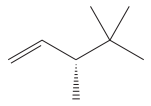
The IUPAC name for the above molecule, without considering the stereochemistry, would be
There is one chiral center in this molecule, and the substituents attached to it are

The first three top-priority substituents are decided by the set of atoms one bond away from the respective points of attachment. The set for the substituent, which is located on the right, is
The configuration at the chiral center of the molecule is designated as above.
(c)
Interpretation:
The R or S configuration of the chiral center in the given molecule is to be designated.
Concept introduction:
When assigning priorities to substituents, the atom having the greater atomic number has the higher priority. In case of comparison between isotopes, the one having the greater atomic mass gets the higher priority. Substituents with double/triple bonds are treated differently from the substituents having only single bonds. An atom that is doubly bonded to another atom is treated as having two single bonds to the atom – one real (shown in black) and one imaginary (shown in red). An atom that is triply bonded to another atom is treated as having three single bonds to the atom – one real (shown in black) and two imaginary (shown in red).
When the fourth priority substituent is pointing away (it is attached by a dash bond) and the first, second, and third priority substituents are arranged clockwise, the configuration is R.
When the fourth priority substituent is pointing away (it is attached by a dash bond) and the first, second, and third priority substituents are arranged counterclockwise, the configuration is S.
If the fourth priority substituent is attached by a wedge bond, then the clockwise or counterclockwise arrangement of the first, second, and third priority substituents is determined, and that arrangement is reversed before assigning R or S.
If the fourth priority substituent is in the plane of the page, then it is switched with the substituent that points away. Then the clockwise or counterclockwise arrangement of the first, second, and third priority substituents is determined, and that arrangement is reversed before assigning R or S.
Answer to Problem C.10P
The configuration of the chiral carbon atom in the given molecule is designated as R.
Explanation of Solution
The given molecule is

The IUPAC name for the above molecule, without considering the stereochemistry, would be
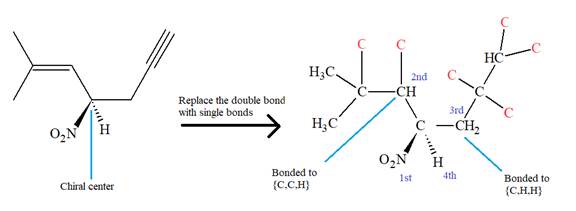
The second and third priority substituents are decided by the set of atoms one bond away from the respective points of attachment. The set for the substituent, which is located on the right, is
The configuration at the chiral center of the molecule is designated as above.
(d)
Interpretation:
The R or S configuration of the chiral center in the given molecule is to be designated.
Concept introduction:
When assigning priorities to substituents, the atom having the greater atomic number has the higher priority. In case of comparison between isotopes, the one having the greater atomic mass gets the higher priority. Substituents with double/triple bonds are treated differently from the substituents having only single bonds. An atom that is doubly bonded to another atom is treated as having two single bonds to the atom – one real (shown in black) and one imaginary (shown in red). An atom that is triply bonded to another atom is treated as having three single bonds to the atom – one real (shown in black) and two imaginary (shown in red).
When the fourth priority substituent is pointing away (it is attached by a dash bond) and the first, second, and third priority substituents are arranged clockwise, the configuration is R.
When the fourth priority substituent is pointing away (it is attached by a dash bond) and the first, second, and third priority substituents are arranged counterclockwise, the configuration is S.
If the fourth priority substituent is attached by a wedge bond, then the clockwise or counterclockwise arrangement of the first, second, and third priority substituents is determined, and that arrangement is reversed before assigning R or S.
If the fourth priority substituent is in the plane of the page, then it is switched with the substituent that points away. Then the clockwise or counterclockwise arrangement of the first, second, and third priority substituents is determined, and that arrangement is reversed before assigning R or S.
Answer to Problem C.10P
The configuration of the chiral carbon atom in the given molecule is designated as R.
Explanation of Solution
The given molecule is
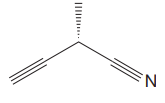
The molecule contains two triple bonds. There is one chiral center in this molecule, and the substituents attached to it are
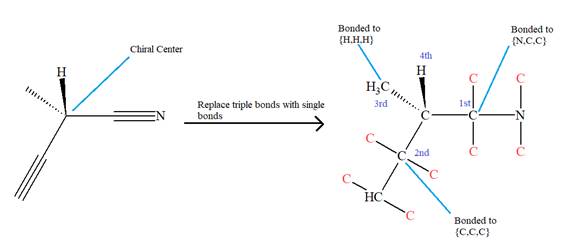
The top three-priorities are decided by the set of atoms one bond away from the respective points of attachment.
The set for the substituent, which is located on the right, is
Given that these substituents are arranged in the counterclockwise manner, but since the fourth-priority substituent is attached by a wedge bond, the arrangement is considered as reverse, that is, clockwise, and the configuration at the chiral center is R. Thus, the configuration at the chiral center for the molecule is R.
The configuration at the chiral center of the molecule is designated as above.
(e)
Interpretation:
The R or S configuration of the chiral center in the given molecule is to be designated.
Concept introduction:
When assigning priorities to substituents, the atom having the greater atomic number has the higher priority. In case of comparison between isotopes, the one having the greater atomic mass gets the higher priority. Substituents with double/triple bonds are treated differently from the substituents having only single bonds. An atom that is doubly bonded to another atom is treated as having two single bonds to the atom – one real (shown in black) and one imaginary (shown in red). An atom that is triply bonded to another atom is treated as having three single bonds to the atom – one real (shown in black) and two imaginary (shown in red).
When the fourth priority substituent is pointing away (it is attached by a dash bond) and the first, second, and third priority substituents are arranged clockwise, the configuration is R.
When the fourth priority substituent is pointing away (it is attached by a dash bond) and the first, second, and third priority substituents are arranged counterclockwise, the configuration is S.
If the fourth priority substituent is attached by a wedge bond, then the clockwise or counterclockwise arrangement of the first, second, and third priority substituents is determined, and that arrangement is reversed before assigning R or S.
If the fourth priority substituent is in the plane of the page, then it is switched with the substituent that points away. Then the clockwise or counterclockwise arrangement of the first, second, and third priority substituents is determined, and that arrangement is reversed before assigning R or S.
Answer to Problem C.10P
The configuration of the chiral carbon atom in the given molecule is designated as R.
Explanation of Solution
The given molecule is
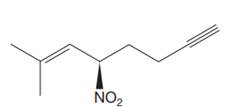
The molecule contains one double bond and one triple bond. There is one chiral center in this molecule, and the substituents attached to it are

The second and third priority substituents are decided by the set of atoms one bond away from the respective points of attachment. The set for the substituent, which is located on the right, is
The configuration at the chiral center of the molecule is designated as above.
Want to see more full solutions like this?
Chapter C Solutions
ORG.CHEM W/TEXT+SOLU.MANUAL
- Draw only the diastereomer(s) of the following moleculearrow_forwardWhat is the hybridizarion of the atom labeled with arrow in each of the following molecules?arrow_forwardCheck the box under each structure in the table that is an enantiomer of the molecule shown below. If none of them are, check the none of the above box under the table.arrow_forward
- Problem: Perform a conformational analysis 2-iodo-2-methylbutane, looking down the C2—C3 bond. Pay attention to the relative energies of the various conformations, but do not concern yourself with the actual energy values. Pleae draw newman projections.arrow_forwardDetermine the # of chiral centers. Determine the most stable chair conformation then indicate which are equatorial and which are axial.arrow_forwardDetermine if ALL 6 (PLEASE LOOK AT BOTH IMAGES, there are TWO) molecules are chiral or achiralarrow_forward
 Organic Chemistry: A Guided InquiryChemistryISBN:9780618974122Author:Andrei StraumanisPublisher:Cengage Learning
Organic Chemistry: A Guided InquiryChemistryISBN:9780618974122Author:Andrei StraumanisPublisher:Cengage Learning
